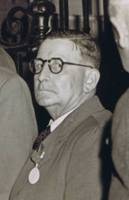
Photograph of Sam by kind permission of Mr Ernest Doubleday

(L to R) 1914-15 Star; British War Medal; Allied Victory Medal; 1939-45 Defence Medal
Samuel, or Sam as he was known, was born on the 16th June 1890 in Macclesfield, Cheshire. His father was called James H. and his mother was Maria. He had an older sister called Ethel and 5 younger brothers: William, James, Harry, Ernest and Herbert. Ernest died between April and June 1903, aged just 3.
James worked as a stoker on a stationary steam engine and in 1891 the family lived at number 2, Court 2, Gresham Street in Westwood, Oldham. By 1901 they had moved to 40 Alfred Street in Chadderton, Oldham. In 1911 James was a general labourer at an electrical engineering company. Sam worked as a cotton spinner at Boundary Mill and the family lived at 551 Hollins Road in Hollinwood, Oldham.
The First World War broke out in August 1914 and Sam joined the Oldham based 10th Battalion of the Manchester Regiment in September, we believe on the 25th. He was given the service number 2711.
The 10th Battalion had been sent to Egypt in early September. They arrived on the same day that Sam enlisted. He will have trained under the soldiers left behind in Oldham with orders to form a reserve for the unit (known as the 2/10th). On the 9th May 1915 the 1/10th Battalion landed in Gallipoli and began to engage in combat with the Turks. They soon began to take casualties and requested reinforcements from the reserve.
Sam was a member of the first draft of 200 reinforcements sent to the 1/10th Battalion. He arrived in Gallipoli on the 23rd July. After a month on the peninsula he was promoted to Corporal.
We don't know why, but Sam left Gallipoli on the 26th November 1915 and returned to the UK. It is likely that he had either been wounded or fallen ill, because in January 1916 he was assigned to the 45th Provisional Battalion. This was a unit made up of soldiers who were unfit for service overseas.
On the 25th March Sam married Bertha Kenyon in Oldham. After their wedding she lived at 250 Ashton Road in Oldham.
Sam was a member of the 45th Provisional Battalion until the 25th August 1916 when he rejoined the 10th Battalion. The 1/10th were in Egypt, so he will have joined the 2/10th, which was now a battalion in its own right, or the 3/10th, which was the reserve.
On the 11th January 1917 Sam left the UK for Egypt. He was posted to the 1/7th Battalion of the Manchester Regiment, a Territorial unit that had served alongside the 1/10th in Gallipoli. Both units were sent to France in early March. At around the same time soldiers in Territorial units were given new service numbers. Sam's was 375794.
The 1/7th Battalion fought around Havrincourt and Achiet during June and July 1917, and then moved north to Ypres in Belgium to take part in the Passchendaele Offensive. They did not take part in any large attacks, and moved to Givenchy that November. This was regarded as a 'quiet' sector, but German fire was still a danger and on the 13th December Sam was badly wounded.
We don't know whether his wound was caused by a shell or a bullet, but it was severe, and doctors were forced to amputate Sam's right leg just above his knee. He spent the next 2 weeks in hospital in France before returning to the UK on New Year's Day 1918.
Sam was taken to the 1st Western General Hospital in Liverpool. By the 24th January his wound had healed and he was able to 'get about on crutches. In the opinion of his doctors he had a 'good stump' that was 'ready to be fitted with an artificial limb'. One was provided during August 1918 at Queen Mary's Convalescent Hospital in Roehampton, south west London.
On the 20th September, whilst still in hospital in Roehampton, Sam was officially assessed as unfit by the Army. He was discharged on the 11th October as 'no longer physically fit for war service'. At this time Sam was 5 feet 3 inches tall. He had a 'fresh' complexion with brown eyes and dark hair. He was awarded a Silver War Badge with serial number B.24106 to show that his discharge was honourable.
Sam returned to Oldham and Bertha. They now lived at 553 Ashton Road, and would remain there until at least 1961. We believe they had 2 children, Clara between January and March 1920 and Ernest between April and June 1925.
We don't know what Sam did immediately after the war, but later in life he worked for Ferranti, an electrical engineering firm based in Oldham. He was working for them during the Second World War of 1939 to 1945, and we believe he also served as an Air Raid Warden. When he retired he was a cost clerk.
As well as his work Sam became an active member of the British Limbless Ex-Servicemans' Association (BLESMA). Bertha died on the 7th October 1961. Sam continued to live in Oldham until he died between April and June 1979, aged 89.
Sam's medals were donated to the Museum of the Manchester Regiment in November 2011.




